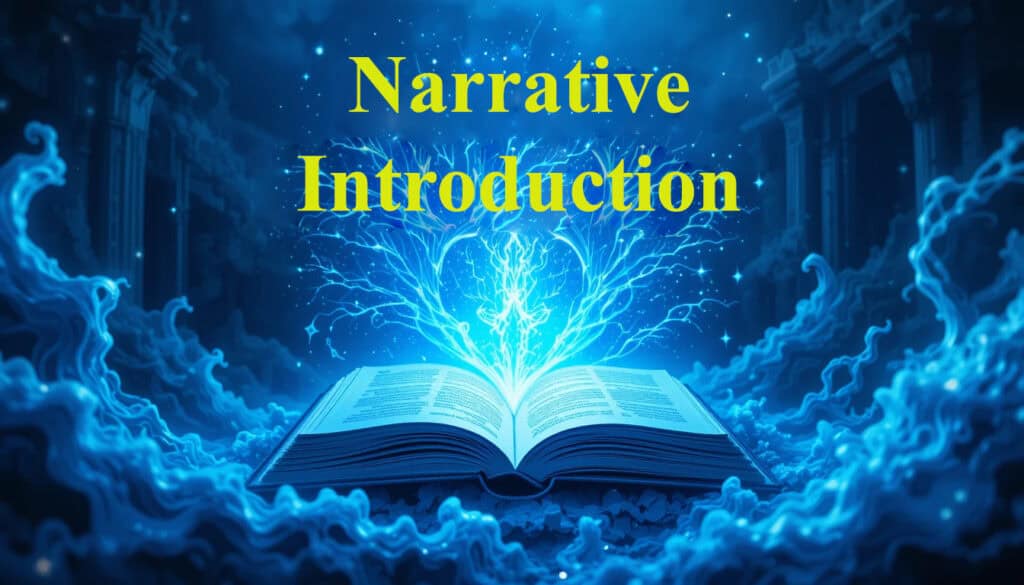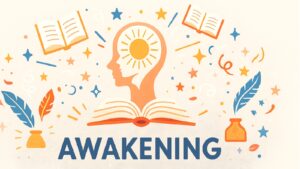Table of Contents
Opening: How the Narrative Introduction Holds the Final Stitch
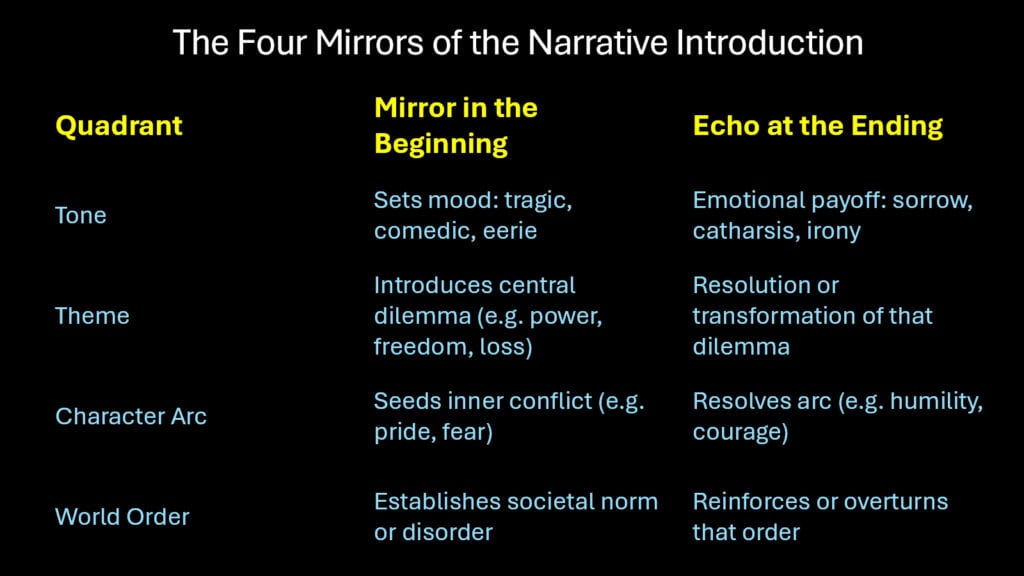
Picture yourself reading the first lines of a novel, where the author places a seemingly innocent detail that will echo through every chapter until it blooms into the story’s final moment. This moment captures the quiet power of the narrative introduction—not merely a doorway into the story but a mirror reflecting its ultimate destination. The opening lines of great literature carry within them the seeds of their conclusions, like DNA strands waiting to unfold their predetermined patterns.
A narrative introduction serves as the architect’s blueprint, carefully constructing reader expectations while establishing the emotional and thematic foundation that will support everything that follows. When Charlotte Perkins Gilman opens “The Yellow Wallpaper” with descriptions of the narrator’s supposed rest cure, she plants the very elements that will drive the story toward its psychological climax. The introduction whispers what the ending will shout.
This phenomenon extends beyond mere literary technique into the realm of storytelling psychology. Readers unconsciously absorb these early signals, forming mental maps that guide their journey through the narrative landscape. The narrative introduction becomes a contract between author and reader, promising certain emotional territories will be explored and specific thematic questions will find resolution.
The six ways explored in this article reveal how masterful writers use their narrative introductions as prophetic instruments. From archetypal patterns that echo across cultures to subtle symbolic threads that weave through entire narratives, these techniques demonstrate how narrative introductions and endings dance together in perfect literary harmony. Each method shows how the narrative introduction functions as both invitation and destination, creating the inevitable feeling that great endings possess.
| Element of Narrative Introduction | Function in Story Arc | Reader Impact |
|---|---|---|
| Character Introduction | Establishes personality traits that drive final conflicts | Creates emotional investment |
| Setting Description | Provides symbolic landscape for thematic resolution | Builds atmospheric expectation |
| Conflict Presentation | Introduces tensions requiring narrative resolution | Generates suspense and anticipation |
| Tone Establishment | Sets emotional register for story’s climactic moments | Prepares psychological response |
| Thematic Hints | Plants philosophical questions explored throughout | Engages intellectual curiosity |
Understanding these connections transforms how we read and write, revealing the invisible threads that bind stories into cohesive wholes.
1. Narrative Introduction as Archetypal Blueprint of the Ending
The human psyche responds to certain universal story patterns with remarkable consistency, and skilled authors tap into these archetypal currents from their very first paragraphs. When Homer begins the Odyssey with Odysseus trapped on Calypso’s island, longing for home, he activates the archetypal pattern of the hero’s journey that will govern every subsequent adventure. The narrative introduction establishes not just plot circumstances but psychological territories that readers recognize at an unconscious level.
Archetypal criticism, developed by scholars like Northrop Frye and Carl Jung, reveals how these universal patterns operate within literary structures. The journey archetype appears when protagonists leave familiar territory in opening scenes, immediately signaling that transformation and eventual return form the story’s backbone. Similarly, the fall archetype emerges when introductions present characters at their peak, subtly preparing readers for the inevitable descent and potential redemption.
Consider how Jane Austen opens “Pride and Prejudice” with the famous declaration about wealthy single men and wives. This narrative introduction activates the archetypal pattern of romantic comedy, where initial misunderstandings and social barriers will eventually dissolve into harmonious union. The archetypal blueprint promises resolution through love’s triumph over pride and social convention, and readers unconsciously prepare for this satisfying conclusion.
The rebirth archetype manifests when narrative introductions present characters or societies in states of decay or stagnation. Charles Dickens employs this pattern in “A Christmas Carol,” opening with Scrooge’s spiritual deadness and social isolation. The archetypal framework immediately suggests that renewal and reconnection will form the story’s climactic moments, even before the first ghost appears.
Modern authors continue exploiting these archetypal foundations. Suzanne Collins opens “The Hunger Games” with Katniss hunting in forbidden territory, immediately activating the archetypal rebel pattern that will drive her eventual revolution against the Capitol. The introduction positions her as the reluctant hero whose personal journey will mirror societal transformation.
| Archetypal Pattern | Narrative Introduction Markers | Ending Implications |
|---|---|---|
| Hero’s Journey | Departure from familiar world | Return with wisdom gained |
| Fall and Redemption | Character at peak status | Humbling followed by growth |
| Romantic Comedy | Social barriers to love | Union despite obstacles |
| Rebirth | Spiritual or physical stagnation | Renewal and transformation |
| Quest | Presentation of worthy goal | Achievement or noble failure |
These archetypal blueprints operate below conscious awareness, creating the sense that great endings feel both surprising and inevitable.
2. Narrative Introduction and the Returning Symbol
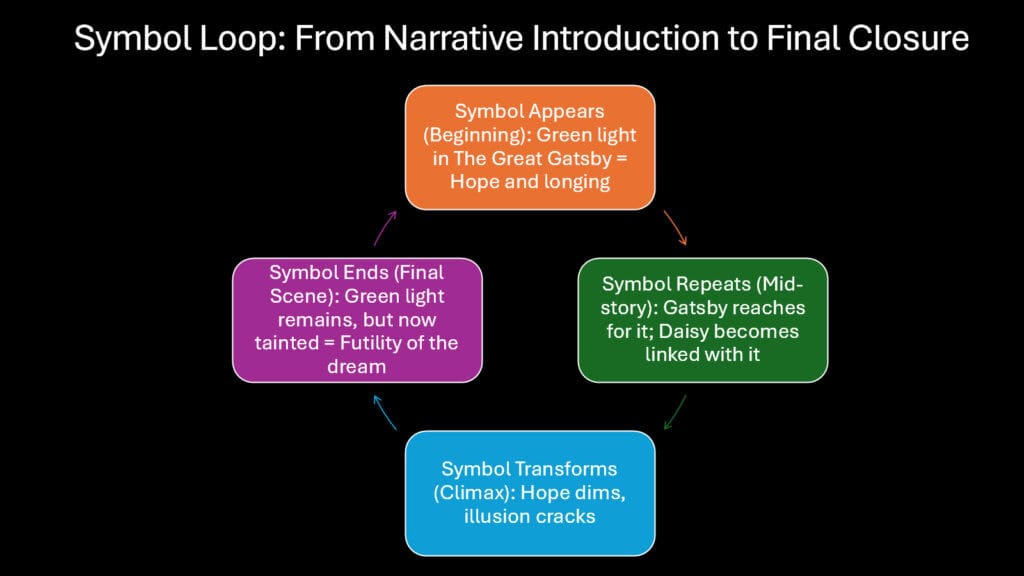
Symbols introduced in opening scenes often carry the emotional weight of entire narratives, appearing transformed at crucial moments to signal thematic resolution. These returning symbols function as literary bookends, framing stories with images that accumulate meaning through repetition and variation. When F. Scott Fitzgerald places the green light across the bay in the opening chapters of “The Great Gatsby,” he creates a symbol that will pulse through every page until its final, devastating appearance.
The power of returning symbols lies in their ability to compress complex emotional and thematic content into single images. Readers attach psychological significance to these objects, gestures, or phenomena during their initial appearance, then experience profound recognition when they resurface at climactic moments. This recognition creates the deep satisfaction that accompanies great literary endings, where disparate elements suddenly coalesce into unified meaning.
Harper Lee demonstrates this technique masterfully in “To Kill a Mockingbird,” where the mockingbird symbol emerges early through Atticus’s advice about not killing these innocent creatures. The symbol accumulates meaning through Tom Robinson’s trial and Boo Radley’s protective actions, finally reaching its full significance in the novel’s resolution. The returning symbol transforms from simple metaphor into the story’s moral center.
Sometimes these symbols undergo deliberate transformation to reflect character growth or thematic development. In “The Scarlet Letter,” Nathaniel Hawthorne introduces the letter “A” as a mark of shame and adultery, but through Hester’s dignity and community service, it gradually transforms into a symbol of able, admirable, and angelic qualities. The symbol’s evolution mirrors the protagonist’s journey from social outcast to respected community member.
Contemporary authors continue exploiting this technique with sophisticated awareness of its psychological impact. In Khaled Hosseini’s “The Kite Runner,” the kite introduced in childhood scenes returns at the novel’s end as a symbol of redemption and connection between generations, completing the protagonist’s emotional journey from guilt to forgiveness.
| Symbolic Element | Initial Appearance | Final Transformation |
|---|---|---|
| Green Light (Gatsby) | Distant hope and longing | Unattainable American Dream |
| Mockingbird (Lee) | Innocent creature advice | Moral lesson about protecting innocence |
| Scarlet Letter (Hawthorne) | Mark of shame | Badge of strength and service |
| Kite (Hosseini) | Childhood competition | Redemptive connection |
| White Whale (Melville) | Object of pursuit | Symbol of obsessive destruction |
These returning symbols create narrative coherence by providing emotional anchors that readers unconsciously track throughout their reading experience.
3. Narrative Introduction as Structural Forecasting
The architecture of opening scenes often mirrors or anticipates the structural patterns that will govern entire narratives, creating mathematical precision beneath seemingly organic storytelling. Freytag’s Pyramid, the classical dramatic structure mapping exposition through resolution, finds its foundation in how authors construct their narrative introductions. These openings don’t simply provide information; they establish the rhythmic patterns and structural expectations that will guide readers through rising action toward climactic revelation.
William Shakespeare demonstrates this structural forecasting in “Hamlet,” where the opening ghost scene establishes the play’s fundamental pattern of appearance versus reality. The uncertain nature of the ghost’s authenticity creates structural tension that will permeate every subsequent scene until the final duel resolves all questions of truth and justice. The structure of the narrative introduction—question, appearance, doubt—serves as the foundation for the play’s exploration of moral certainty.
Modern authors employ structural forecasting with increasing sophistication. Virginia Woolf opens “Mrs. Dalloway” with Clarissa’s decision to buy flowers herself, establishing the stream-of-consciousness technique and temporal fluidity that will characterize the entire novel. The structure of the narrative introduction—present action triggering memory and reflection—creates the architectural framework for the story’s exploration of time and consciousness.
The structural relationship between narrative introduction and ending often involves deliberate symmetry or revealing contrast. Gabriel García Márquez opens “One Hundred Years of Solitude” with José Arcadio Buendía facing execution while remembering his father taking him to see ice, then closes with Aureliano deciphering prophecies that reveal the family’s cyclical destiny. The structural pattern moves from memory to prophecy, from ice to wind, creating perfect narrative architecture.
Some authors use structural forecasting to establish genre expectations that they later subvert or fulfill in unexpected ways. Agatha Christie opens “The Murder of Roger Ackroyd” with seemingly conventional mystery exposition, but the structural elements she introduces—unreliable narration and reader assumptions—become the very mechanisms through which she delivers her shocking conclusion.
| Structural Element | Functions of Narrative Introduction | Resolution Impact |
|---|---|---|
| Temporal Framework | Establishes time manipulation rules | Governs climactic revelations |
| Narrative Voice | Sets perspective limitations | Determines ending’s revelation method |
| Conflict Introduction | Presents central tensions | Shapes resolution requirements |
| Pacing Establishment | Creates rhythmic expectations | Influences climactic timing |
| Genre Signals | Activates reader assumptions | Enables satisfaction or subversion |
This structural forecasting creates the underlying architecture that makes great endings feel both inevitable and surprising.
4. Narrative Introduction and Emotional Tone-Setting
The emotional atmosphere established in opening scenes creates psychological gravitational fields that pull narratives toward specific kinds of endings, regardless of plot mechanics or character decisions. This tone-setting function operates at subliminal levels, preparing readers’ emotional responses while establishing the affective landscape through which all subsequent events will be interpreted. When Edgar Allan Poe opens “The Fall of the House of Usher” with descriptions of decay and unnatural dread, he creates an emotional trajectory that can only resolve in catastrophe.
Tone functions as emotional DNA, encoding the story’s ultimate destinations within its earliest moments. The melancholy that permeates the opening of “The Great Gatsby” doesn’t simply describe Nick Carraway’s mood; it establishes the elegiac tone that will color every party, every conversation, every moment of hope until the final image of boats borne back against the current. This emotional undertow makes the tragic ending feel psychologically necessary rather than arbitrary.
Authors manipulate tone-setting with remarkable precision, often layering multiple emotional registers to create complex psychological effects. Charlotte Brontë opens “Jane Eyre” with the young protagonist’s isolation and defiance in the Reed household, establishing both vulnerability and fierce independence that will characterize her entire journey. The emotional tone promises triumph over adversity while acknowledging the psychological costs of such victories.
Sometimes authors deliberately establish false emotional tones to create powerful dramatic irony. Shirley Jackson opens “The Lottery” with cheerful descriptions of a beautiful summer day and community gathering, creating jarring contrast with the story’s horrific conclusion. The tonal misdirection makes the ending more shocking while commenting on civilization’s capacity for sanctioned violence.
Contemporary authors often employ emotional tone-setting to explore psychological rather than plot-driven narratives. Ian McEwan opens “Atonement” with languid descriptions of a hot summer day filled with creative energy and romantic possibilities, establishing the nostalgic tone that will haunt every subsequent chapter as characters confront the consequences of a child’s misunderstanding.
| Emotional Tone | Opening Establishment | Ending Fulfillment |
|---|---|---|
| Elegiac Melancholy | Nostalgic description of past | Loss and memory reconciliation |
| Gothic Dread | Atmospheric menace | Supernatural or psychological horror |
| Romantic Optimism | Love’s possibilities | Union or noble sacrifice |
| Satirical Irony | Social criticism | Exposure of hypocrisy |
| Existential Anxiety | Philosophical questioning | Acceptance or absurd revelation |
These emotional trajectories create the psychological inevitability that distinguishes memorable endings from arbitrary plot conclusions.
5. Narrative Introduction as Reader’s Unconscious Guide
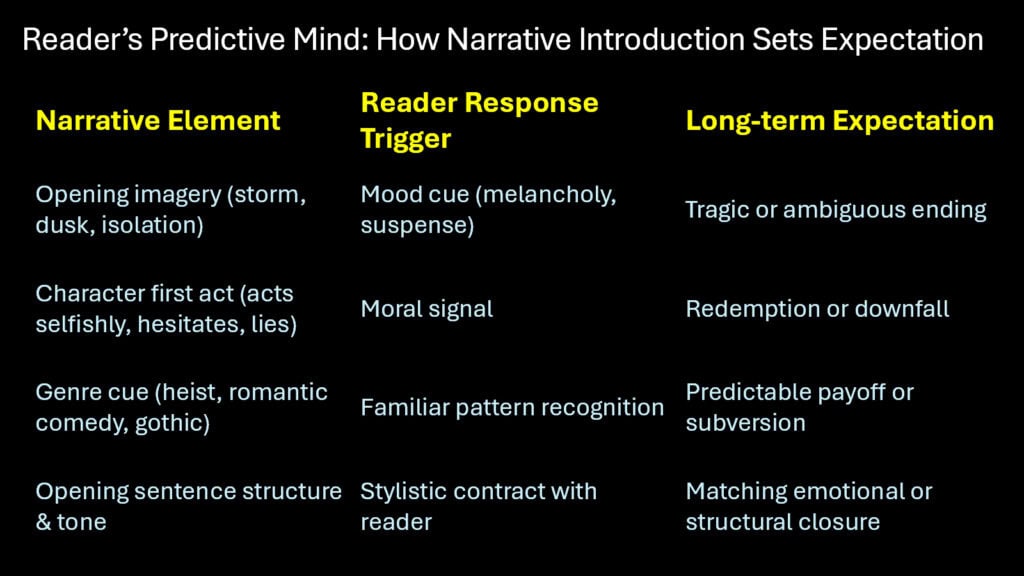
The opening scenes of powerful narratives function as psychological programming, establishing mental frameworks that guide reader expectations and emotional responses throughout the storytelling experience. Reader-Response Theory, developed by scholars like Wolfgang Iser and Stanley Fish, reveals how audiences actively participate in meaning creation, but this participation follows patterns established by the narrative introduction’s careful manipulation of cognitive and emotional cues.
Readers form unconscious predictions within the first few paragraphs of any story, drawing upon genre recognition, character psychology, and tonal atmosphere to construct mental maps of probable outcomes. These predictions operate below conscious awareness, creating the sense of satisfaction or surprise that accompanies different types of endings. When authors understand this psychological process, they can orchestrate reader responses with remarkable precision.
Consider how Arthur Conan Doyle opens Sherlock Holmes stories with specific patterns of mystery presentation that train readers to expect logical resolution through deductive reasoning. The narrative introduction establishes the detective’s methodology while presenting puzzles designed to engage reader participation in solution-seeking. This psychological preparation makes the eventual explanations feel both surprising and inevitable.
Modern authors exploit reader psychology with increasing sophistication. Gillian Flynn opens “Gone Girl” with Nick’s seemingly straightforward account of his wife’s disappearance, carefully establishing reliability cues that she will later systematically dismantle. The introduction programs readers to trust the narrator while planting subtle inconsistencies that will eventually justify their growing unease.
The psychological preparation extends beyond plot prediction to emotional readiness. When Toni Morrison opens “Beloved” with the house number 124 being spiteful, she prepares readers for a narrative that will blur boundaries between living and dead, past and present. This psychological framework enables readers to embrace supernatural elements that could otherwise seem disconcerting or implausible.
Authors also use introductions to establish reading contracts with their audiences, signaling what kinds of intellectual and emotional engagement the story will require. The opening of Thomas Pynchon’s “Gravity’s Rainbow” immediately signals that readers must prepare for complex, paranoid narratives where traditional causality may not apply.
| Reader Psychology Element | Techniques of Narrative Introduction | Ending Response |
|---|---|---|
| Expectation Formation | Genre and character cues | Satisfaction or subversion |
| Emotional Preparation | Tonal atmosphere | Psychological readiness |
| Trust Establishment | Narrator reliability signals | Betrayal or confirmation |
| Cognitive Framework | Logic and causality rules | Mental processing ability |
| Attention Direction | Focus on specific elements | Recognition and resolution |
This unconscious guidance creates the reading experience’s emotional architecture, determining how audiences will receive and interpret climactic moments.
6. Narrative Introduction as Genre Compass
The opening moments of stories function as navigational instruments, establishing genre conventions that create reader expectations about narrative rules, character behavior, and resolution patterns. These genre signals operate as implicit contracts between authors and audiences, promising specific types of satisfaction while establishing the boundaries within which stories will operate. When authors honor these contracts, they create the deep satisfaction of fulfilled expectations; when they violate them strategically, they achieve the shock of subverted assumptions.
Mystery fiction demonstrates this principle clearly, with authors like Agatha Christie using narrative introductions to establish the closed-world logic of detective fiction. The presentation of victims, suspects, and investigators in opening chapters activates reader knowledge of genre conventions while establishing the specific rules this particular mystery will follow. The narrative introduction becomes a compass pointing toward logical resolution through systematic investigation.
Horror fiction employs genre signals differently, using introductions to establish the supernatural or psychological rules that will govern frightening events. Stephen King opens “The Shining” with Jack Torrance’s job interview at the Overlook Hotel, establishing both realistic psychological deterioration and supernatural malevolence as possible explanations for coming terror. The genre compass points toward horror while leaving specific mechanisms deliberately ambiguous.
Romance fiction uses narrative introductions to establish the social and emotional obstacles that must be overcome for love to triumph. Jane Austen’s openings consistently present class differences, personality conflicts, or social expectations that create barriers to romantic union, immediately signaling that the narrative will work toward overcoming these specific impediments. The genre compass indicates a journey towards ultimate emotional fulfillment achieved through the triumph of love.
Satirical fiction employs introductions to establish targets for social criticism while signaling the comic or tragic methods through which that criticism will be delivered. Jonathan Swift opens “A Modest Proposal” with seemingly reasonable discussion of Irish poverty, establishing the rational tone that makes his shocking suggestion more powerful. The genre compass points toward social commentary through ironic exposure.
Contemporary authors often blend genre signals to create hybrid narratives that expand traditional boundaries. Margaret Atwood opens “The Handmaid’s Tale” with elements of both science fiction and literary realism, creating a genre compass that points toward both speculative warning and character-driven exploration of oppression.
| Genre Category | Introduction Signals | Resolution Expectations |
|---|---|---|
| Detective Mystery | Crime, suspects, investigator | Logical solution revelation |
| Gothic Horror | Atmospheric menace, isolation | Supernatural or psychological terror |
| Romantic Comedy | Social barriers to love | Emotional union despite obstacles |
| Social Satire | Cultural criticism setup | Exposure of hypocrisy or folly |
| Coming-of-Age | Youth facing adult challenges | Growth through experience |
These genre compasses provide the navigational frameworks that allow readers to engage fully with narrative journeys toward their predetermined destinations.
Closing the Circle: Why the Narrative Introduction Establishes The End
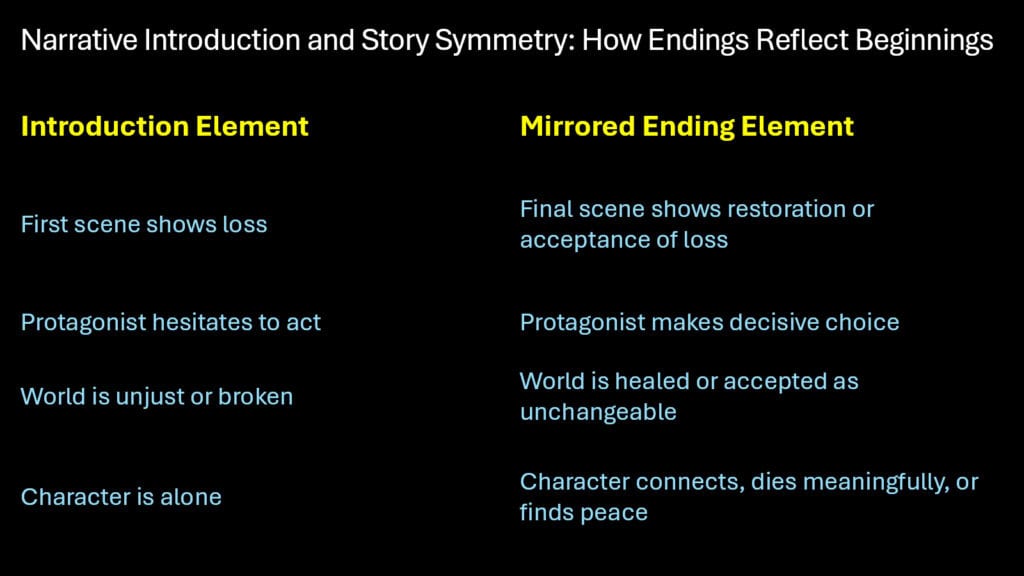
The exploration of these six methods reveals a fundamental truth about masterful storytelling: every memorable ending exists in embryonic form within its narrative introduction, waiting for the proper conditions to bloom into full revelation. This connection between beginning and ending transcends mere technical craft to touch something essential about human psychology and the nature of satisfying narrative experience. We crave stories that feel both surprising and inevitable, and this paradoxical satisfaction emerges from the careful planting of seeds that we recognize only when they bear fruit.
The archetypal patterns, returning symbols, structural forecasting, emotional tone-setting, psychological guidance, and genre signaling explored in this article represent different facets of the same essential phenomenon: the narrative introduction’s function as soft prophecy. These techniques work together to create the sense that great endings were always present, hidden in plain sight within opening paragraphs that seemed to offer simple exposition or character introduction.
This understanding transforms both reading and writing practices. Readers who recognize these patterns develop deeper appreciation for literary artistry while experiencing enhanced emotional satisfaction from well-crafted conclusions. Writers who master these techniques gain the ability to create the inevitable feeling that distinguishes memorable stories from arbitrary sequences of events.
The relationship between beginning and ending also reflects larger truths about human experience and meaning-making. We understand our lives through narrative patterns, constantly seeking connections between past and present that will illuminate future possibilities. Literature that successfully connects its beginnings to its endings provides psychological satisfaction because it mirrors our own attempts to find coherence and purpose in temporal existence.
Perhaps most importantly, this exploration reveals that great stories don’t simply end—they complete circles that were drawn from their very first words. The narrative introduction serves as both invitation and destination, creating the quiet magic that makes readers close books with the satisfied feeling that they have witnessed something both surprising and utterly right.
| Integration Element | Function in Complete Narrative | Reader Experience |
|---|---|---|
| Thematic Coherence | Unifies all narrative elements | Intellectual satisfaction |
| Emotional Resonance | Creates lasting psychological impact | Memorable reading experience |
| Structural Unity | Provides architectural completeness | Aesthetic appreciation |
| Symbolic Completion | Fulfills metaphorical promises | Deep recognition |
| Psychological Closure | Satisfies unconscious expectations | Emotional fulfillment |
The beginning always knows the end because both emerge from the same creative vision, the same understanding of what the story needs to become whole.

